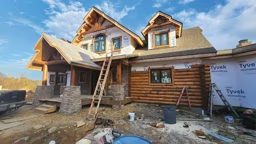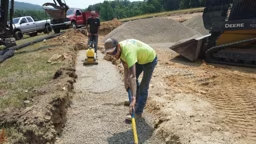
Log homes announce their difference from ordinary homes right off the bat by the way they are sold. Dozens of companies sell log homes, but they do so their own way. Although wood is the primary construction material, what each company does to the logs makes its homes stand out from others. Even homes made from the same logs for the same floor plan are likely to turn out differently.
This variety appeals to many buyers, who welcome the opportunity to create a distinctive, personalized home. To cater to this specialized consumer demand, two entirely different groups of log home producers have emerged: manufacturers and handcrafters. Their methods differ, but their goal remains the same: to provide the logs to build your dream home. Manufacturers account for roughly 90 percent of log home production in the United States. Handcrafters produce the remaining 10 percent. The two kinds of producers differ not just in the look of their homes, but also in the ways they make, deliver, price and erect them.
See also The App That Will Keep You on Budget
Manufacturers
Log home manufacturers produce their logs using modern, high-speed, precision woodworking machinery. This equipment enables manufacturers to take raw logs and cut them into intricate, consistent shapes. The key to the manufactured, or milled, log is the uniformity of the top and bottom horizontal surfaces that fit together. Every log passing through the log mill is cut to very close tolerances so that the prepared timbers fit snugly together when stacked in a log wall. The visible vertical surfaces are often milled to uniform dimensions, although some manufacturers peel these surfaces by hand after milling to produce a more rustic, natural look that many people associate with log homes.
Although some log home manufacturers sell directly to consumers, many sell their homes through a network of sales representatives, generally referred to as builder-dealers or simply dealers. Most of these dealers are full-time representatives.
Log home manufacturers locate their mills in areas accessible to ample quantities of the wood species they prefer. Operating from their plant, they generally sell the bulk of their production within 500 miles. Some companies have expanded to reach a broader market, even venturing abroad.
See also 20 Tips for the Perfect Floor Plan
The Building System
Most log home manufacturers produce homes according to their proprietary building systems. A building system is the master structural engineering plan that defines how components are connected to one another and how, once connected, they interact. Such a plan ensures that every home produced according to the system will be structurally sound.
Developing a building system requires a considerable amount of engineering. After the system is developed and the necessary engineering design work is complete, the manufacturer can apply the system’s engineering principles to many different styles of homes. Once a company receives code approval, it can erect log homes built according to its approved system anywhere in the country.
Erecting the Home
Often, log home manufacturers don’t build the homes they produce. Instead, they primarily create design and construction drawings, produce the logs and supply related building materials. They then ship these materials — with blueprints and a construction manual detailing how to assemble the home according to their particular building system — to their builder-dealer, the buyer or an independent builder that the buyer has designated.
Manufacturers work closely with the builder to ensure that the home is erected according to their system. Often, companies will send a crew to stack the logs or someone to supervise the process. Generally, manufacturers or their representatives agree to provide a specified number of hours of technical assistance on the job site to ensure the homes they sell are properly erected. Technical assistance should be stated as part of the manufacturer’s sales contract.
See also What is a Structural Envelope and Why You Should Focus on It
Delivery Schedules
The production capacity of manufacturers varies, but generally once the plans for a log home are complete, they need only a few days to cut and mill the logs for an average-size home and only a week or two after that to deliver it. During busy seasons, usually late spring and summer, companies may be cutting dozens of homes at the same time. As a result, delivery can take six to eight weeks.
Payment Schedules
Payment schedules also vary, but nearly all log home manufacturers require a deposit at the time of signing a contract for a log home materials package — the so-called kit that contains the logs and various other materials that go into building the home. Many manufacturers’ required deposits are refundable; some are not. Make certain that you have a written statement explaining the company’s policy before you give anyone a check.
If the company prepares construction drawings or does any amount of design work, the cost is generally deducted from the deposit if you decide not to order the home. Once you approve the design and authorize the company to cut the logs, you’ll likely be asked for anywhere between 25 and 50 percent of the package price.
Most companies require payment in full, either before the logs are actually loaded on a truck for shipment or when the delivery truck arrives at your building site before unloading begins. A certified cashier’s check is generally required for this final payment.
See also Choosing Logs
Handcrafters
Log home handcrafters tend to be smaller operations than their manufactured cousins. Most produce the logs for their homes much the same way early settlers did. They may actually go into the woods and individually select the trees they intend to use. Using hand-held tools, they then remove the bark from the trees and cut and shape each log. Some of these tools are power assisted — chainsaws, chippers, sanders — but others are the same type of tools used for centuries, such as the broad ax, adze and chisel.
The way handcrafters select and cut their logs differs significantly from the methods used by manufacturers that stress uniformity of their logs. Handcrafters generally select logs that span the full length of a wall, and each log is cut and shaped to fit one specific location in the home. When a handcrafter works with full-round logs, each log retains the shape of the tree. Logs are often thicker at the bottom (“butt end”) than at the top of the tree. This natural taper requires that handcrafters alternate stacking logs in their walls — butt to top, then top to butt and so on — so that the wall’s height remains level.
Handcrafters also work with square or rectangular logs, usually with dovetail corners. They cut these logs to a uniform shape with a saw, adze or broad ax and then need only cut corner notches to fit properly in the home.
See also Why Your Relationship with Your Builder is Crucial During the Construction Phase
Handcrafting Operations
Handcrafters customarily work in groups of two or three skilled individuals per company. They custom build every home in the traditional sense of the word, cutting and shaping every log for its precise location within the structure. The logs they select for your home are brought to the yard and pre-assembled on a temporary foundation to check their fit. Then, they’re numbered to record their exact location in the home, disassembled and trucked to the building site for re-erection and finishing.
There are schools that teach the craft but no governmental agencies that regulate or set standards for handcrafted homes. Each handcrafter is an artisan, and the finished home is often a true work of art. Because the demand today is for more complex handcrafted homes, more and more of these artisans are working with engineers and architects for the structural design calculations required to meet building codes.
Handcrafter Payments
Payment terms vary among handcrafters. Generally, they expect a down payment of from one-fourth to one-third of the total when you approve the plans for your home. Once work gets under way, progress payments normally are required. Final payment, depending on your handcrafter, will be due before the logs leave the yard, when the logs are erected or, if the handcrafter is also doing your finishing work, when the job has been completed.
Delivery Schedules
Smaller handcrafters often require advance notice of several months to a year to produce a home. Since they generally work with a limited number of logsmiths and can produce just a few homes at a time, their delivery schedules are obviously very different from those of manufacturers.











